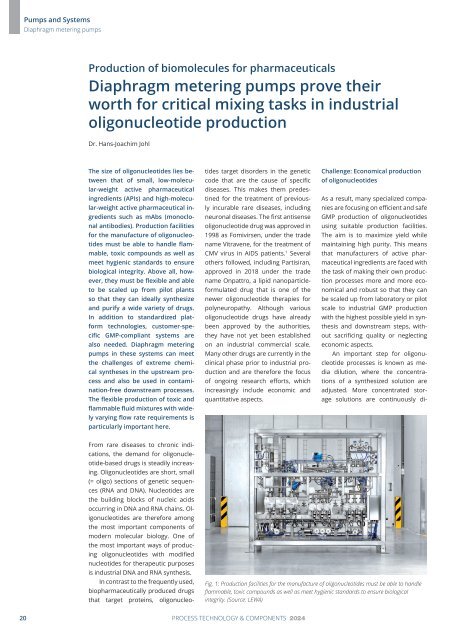PuK - Process Technology & Components 2024
A technical trade magazine with a history of more than 60 years.
A technical trade magazine with a history of more than 60 years.
Create successful ePaper yourself
Turn your PDF publications into a flip-book with our unique Google optimized e-Paper software.
Pumps and Systems<br />
Diaphragm metering pumps<br />
Production of biomolecules for pharmaceuticals<br />
Diaphragm metering pumps prove their<br />
worth for critical mixing tasks in industrial<br />
oligonucleotide production<br />
Dr. Hans-Joachim Johl<br />
The size of oligonucleotides lies between<br />
that of small, low-molecular-weight<br />
active pharmaceutical<br />
ingredients (APIs) and high-molecular-weight<br />
active pharmaceutical ingredients<br />
such as mAbs (monoclonal<br />
antibodies). Production facilities<br />
for the manufacture of oligonucleotides<br />
must be able to handle flammable,<br />
toxic compounds as well as<br />
meet hygienic standards to ensure<br />
biological integrity. Above all, however,<br />
they must be flexible and able<br />
to be scaled up from pilot plants<br />
so that they can ideally synthesize<br />
and purify a wide variety of drugs.<br />
In addition to standardized platform<br />
technologies, customer-specific<br />
GMP-compliant systems are<br />
also needed. Diaphragm metering<br />
pumps in these systems can meet<br />
the challenges of extreme chemical<br />
syntheses in the upstream process<br />
and also be used in contamination-free<br />
downstream processes.<br />
The flexible production of toxic and<br />
flammable fluid mixtures with widely<br />
varying flow rate requirements is<br />
particularly important here.<br />
From rare diseases to chronic indications,<br />
the demand for oligonucleotide-based<br />
drugs is steadily increasing.<br />
Oligonucleotides are short, small<br />
(= oligo) sections of genetic sequences<br />
(RNA and DNA). Nucleotides are<br />
the building blocks of nucleic acids<br />
occurring in DNA and RNA chains. Oligonucleotides<br />
are therefore among<br />
the most important components of<br />
modern molecular biology. One of<br />
the most important ways of producing<br />
oligonucleotides with modified<br />
nucleotides for therapeutic purposes<br />
is industrial DNA and RNA synthesis.<br />
In contrast to the frequently used,<br />
biopharmaceutically produced drugs<br />
that target proteins, oligonucleotides<br />
target disorders in the genetic<br />
code that are the cause of specific<br />
diseases. This makes them predestined<br />
for the treatment of previously<br />
incurable rare diseases, including<br />
neuronal diseases. The first antisense<br />
oligonucleotide drug was approved in<br />
1998 as Fomivirsen, under the trade<br />
name Vitravene, for the treatment of<br />
CMV virus in AIDS patients. 1 Several<br />
others followed, including Partisiran,<br />
approved in 2018 under the trade<br />
name Onpattro, a lipid nanoparticleformulated<br />
drug that is one of the<br />
newer oligonucleotide therapies for<br />
polyneuropathy. Although various<br />
oligonucleotide drugs have already<br />
been approved by the authorities,<br />
they have not yet been established<br />
on an industrial commercial scale.<br />
Many other drugs are currently in the<br />
clinical phase prior to industrial production<br />
and are therefore the focus<br />
of ongoing research efforts, which<br />
increasingly include economic and<br />
quantitative aspects.<br />
Challenge: Economical production<br />
of oligonucleotides<br />
As a result, many specialized companies<br />
are focusing on efficient and safe<br />
GMP production of oligonucleotides<br />
using suitable production facilities.<br />
The aim is to maximize yield while<br />
maintaining high purity. This means<br />
that manufacturers of active pharmaceutical<br />
ingredients are faced with<br />
the task of making their own production<br />
processes more and more economical<br />
and robust so that they can<br />
be scaled up from laboratory or pilot<br />
scale to industrial GMP production<br />
with the highest possible yield in synthesis<br />
and downstream steps, without<br />
sacrificing quality or neglecting<br />
economic aspects.<br />
An important step for oligonucleotide<br />
processes is known as media<br />
dilution, where the concentrations<br />
of a synthesized solution are<br />
adjusted. More concentrated storage<br />
solutions are continuously di-<br />
Fig. 1: Production facilities for the manufacture of oligonucleotides must be able to handle<br />
flammable, toxic compounds as well as meet hygienic standards to ensure biological<br />
integrity. (Source: LEWA)<br />
20 PROCESS TECHNOLOGY & COMPONENTS <strong>2024</strong>

















